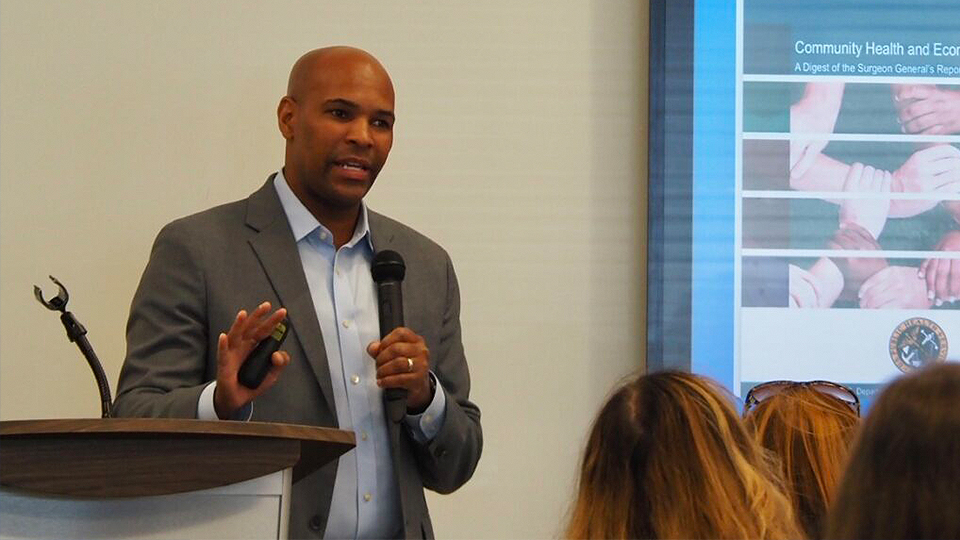‘We better get it right’: Health experts talk new funding, laws
Subscriber Benefit
As a subscriber you can listen to articles at work, in the car, or while you work out. Subscribe Now
Indiana made national headlines in the spring when lawmakers authorized $275 million in public and behavioral health funding — a massive increase — but now, the state’s health systems must execute.
“It marks a notable deviation from the approach that many other conservative states have taken at the time, so we’re receiving national attention. That’s a good thing,” said former U.S. Surgeon General and former Indiana Health Commissioner Jerome Adams.
“But I also want to let you know that people are watching us. They’re watching what we’re going to do over the next couple of years with this funding, so we better get it right,” Adams continued. He spoke Thursday at a health-focused event hosted by Indianapolis-based life sciences organization BioCrossroads and moderated by Inside INdiana Business Reporter Kylie Veleta..
The fight for new funding
The sweeping Senate Enrolled Act 1 aims to fortify the year-old 988 crisis response center and hotline with funding for mental health emergencies. Lawmakers hoped to deliver on three elements: someone to call for help, someone to respond and somewhere to go.
The two-year budget allots $50 million annually to the effort — more than the previous $35 million but far short of the $150 million that a fall 2022 state report requested.
And Senate Enrolled Act 4 will give counties additional funds in exchange for providing enhanced public health services and complying with reporting and metrics requirements. It’s an opt-in system.
Indiana has long recorded poor health metrics — and it ranks 48th in the nation for public health funding, spending $55 per capita versus the nationwide average of $91 per capita.
Lawmakers funded that effort with $75 million in the budget’s first year, followed by $150 million the next. That’s less than half of the original ask and roughly two-thirds of Gov. Eric Holcomb’s proposal.
“We have been reactive in our approach to health care and this is a momentous time where I think we were proactive,” said Rep. Brad Barrett, a retired surgeon now representing Richmond as a Republican.
“It’s the first time we’ve made a significant state investment in public health,” he added.
Barrett said the state’s “pitiful metrics” meant lawmakers of both parties agreed on the problem, but struggled to come together on solutions amid pandemic-born distrust of public health initiatives, fears of government overreach and rural-urban tensions.
Counties have until September 1 to opt in — and so far, 75 have, Barrett said.
That number doesn’t include his own county, though. He said officials there were working on it: trying to maximize the funds that would be spent on services and avoid increases in capital and payroll expenditures.
Adams told the Capital Chronicle in a separate interview that a lot of mistrust remains in Indiana and the nation.
“A lot of trust was lost during the pandemic because of our inability to communicate a lot of rapidly changing aspects of the pandemic. I think moving forward we need to double down on health communication and really improve the way that we interact with with folks,” he said. “What I try to do is speak to people in a language that resonates and … in a way that takes some of these complex health issues and boils them down to terms that people can more easily understand — and not really leaning on the moral or the political arguments so much as the pragmatic arguments that I think resonate with Hoosiers.”
He also emphasized ensuring that counties have access to the technical expertise required to comply with the legislation’s requirements, and enough trust in the state to take the leap.
But because the budget is a two-year deal, there’s no guarantee on the follow-through.
“My only reservation is that things are going to take some time to get long-term results,” Barrett said. “And some of these things aren’t fixable, aren’t measurable (short-term). I think it’s a real challenge for our counties to come up with some metrics and performance indicators that are short-term that we can say, “Hey, two or three years, we made a difference.”
But officials were hopeful that this legislative session’s health efforts would provide a solid foundation for future work.
Barrett compared the state’s health care status to an overwhelmingly cluttered garage.
“I look at that mess and it’s unbelievable, you know — where do you start? My new strategy is to start in the corner and good things happen. You … hang up some gloves, you hang the rake,” he said, to laughter. “And that’s where I think we are.”
The Indiana Capital Chronicle is an independent, not-for-profit news organization that covers state government, policy and elections.
